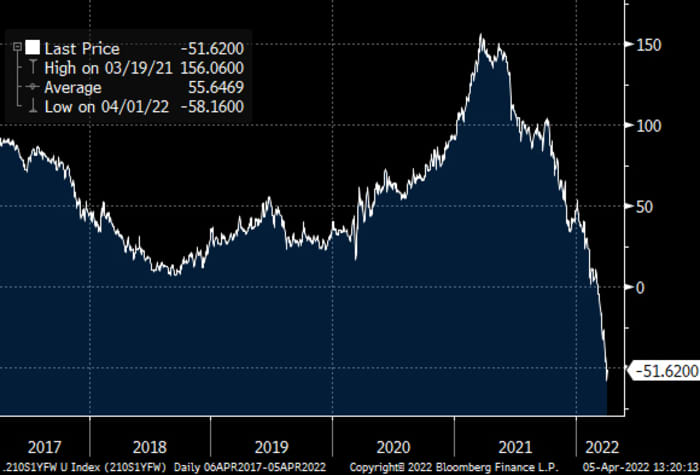This post was originally published on this site
A forward indicator of the U.S. Treasury yield curve is pointing to the prospect of a much more deeply negative inversion of the widely followed 2-year, 10-year spread than what’s been seen since last week.
The forward 2s/10s curve, which measures where traders expected the 2s/10s spread to be a year out from now, was at minus 51.6 basis points on Tuesday, according to Ben Emons, managing director of global macro strategy at Medley Global Advisors. That compares with minus 10 basis points briefly seen in the spot 2s/10s spread on Monday. The last time the 2s/10s spread inverted by 50 basis points or more was in 2000, when the dot-com bubble of the late 1990s burst.

Source: Bloomberg
An inversion of the 2s/10s spread is often seen as a harbinger of an economic recession, albeit with a long lag, though there’s debate over whether that gauge is the most reliable indicator. More than half of the 525 respondents to Bloomberg’s Markets Live weekly survey, though, agreed that the 2s/10s spread gives the best recession warning of any part of the Treasury curve. Forty-eight percent of those respondents also said a U.S. recession is most likely to start next year.
A deeply inverted Treasury curve doesn’t automatically translate into a deep recession, however, Emons said via phone. It generally means that the Federal Reserve’s main policy rate target will be trading so far above the 10-year Treasury rate that it will “negatively” affect the economy, he said. And “no recession has ever happened without an inversion.”
Related: Why an inverted yield curve is a bad tool for timing the stock market
“A deeply inverted curve makes sense in an environment in which the Fed reasserts its inflation credibility,” according to a Deutsche Bank research note released on Tuesday.
In One Chart: Stocks are rallying because an inverted yield curve says more about inflation than economic growth, strategist says
Also on Tuesday, Federal Reserve Gov. Lael Brainard lent credence to the notion of a central bank preparing to assert itself more aggressively to combat inflation. Brainard said she expects the central bank’s almost $9 trillion balance sheet to “shrink considerably more rapidly” than in the previous recovery. She also said “inflation is much too high and is subject to upside risks,” and that “it is of paramount importance to get inflation down.”
Investors aggressively sold off Treasurys after her remarks, sending the 2-
TMUBMUSD02Y,
and 10-year
TMUBMUSD10Y,
yields to their highest levels, respectively, since March and April of 2019.


